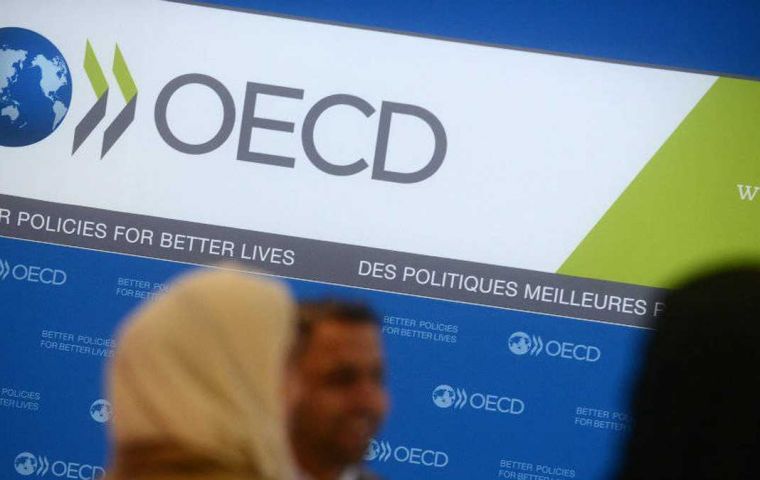MercoPress. South Atlantic News Agency
OECD's May report foresees 5.8% growth for 2021
 Of the economies surveyed by the OECD, Argentina is the one that ranks last.
Of the economies surveyed by the OECD, Argentina is the one that ranks last. The world's economy is forecast to grow 5.8% in 2021, according to the Organization for Economic Cooperation and Development (OECD), “Economic prospects: an unusual recovery. Navigating towards the transition,” it has been announced.
The new report, which analyses data up to Mayo this year, would show a significant improvement from projections made in December 2020, which estimated it at 4.2%.
This review is in line with other international organizations, which advances of vaccination and the strong growth that the United States would record as a result of the “enormous fiscal stimulus” set in place.
For 2022, global growth would be around 4.4%. Despite the improvement, the 2021-2022 performance will not be enough to recover what the crisis has taken away when focused from the GDP per capita prior to the outbreak of the pandemic.
In the case of Brazil, which grew 1.2% in the first quarter in seasonally adjusted terms and reached the level of prepandemic GDP, an annual expansion of 3.7% is projected for 2021 and 2.5% for 2022. But the GDP per capita will be lower than in 2019, at least until the last stretch of 2022.
Argentina's recent performance has not been enough to make up for what was lost during 2020 and GDP is close to 4% below prepandemic levels. With a GDP growth outlook of 6.1% and 1.8% for the next biennium, it would take five years for GDP per capita to reach that threshold. In fact, of the economies surveyed by the OECD, Argentina is the one that ranks last from this angle.
Moreover, inflation in the United States has become a significant piece of information, something unthinkable in 2019 or before and a monthly increase of 0.6% for the consumer price index (CPI) during the month of May became worthwhile noticing to OECD, since it placed yoy inflation at around 5%, above market expectations. In August 2008, the 12-month inflation reached 5.4%.
Regarding the core of prices, whose evolution reflects the underlying inflationary pressures -inasmuch as it excludes the most volatile prices-, the increase was 0.7% per month and 3.8% in relation to the same month of the previous year.
Interannual comparisons show in every item the effects of the pandemic and the measures widely deployed to curb infections, which has led to two months of high inflation by US standards and above the 2% annual target established by the Federal Reserve, which measures not CPI, but personal consumption expenditure (PCE) rather.
Analysts still debate whether this is a transition process or a phenomenon set to have a stronger impact over time in a discussion that leaves scholar settings and hits political arenas with debates concverning support to reactivate the economy and strengthen social protection.
The recent increase in prices is interpreted by Republicans as an the consequence of unwise moves by the administration of Prersident Joseph Biden. Kevin Cramer, a Republican senator and a member of the Senate's Banking Committee, said this “should have a sobering effect on anyone who insists on thinking that somehow the country needs more stimulus, or that the country needs more free money.”
In this scenario, the Federal Reserve meeting for the month of June will take place. FR head Jerome Powell's stance on these issues is highly awaited to shed some little light on the progress of monetary policy in the coming months, something that will affect exchange rates and other indexes, especially in emerging economies.




Top Comments
Disclaimer & comment rulesCommenting for this story is now closed.
If you have a Facebook account, become a fan and comment on our Facebook Page!